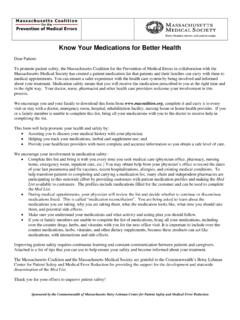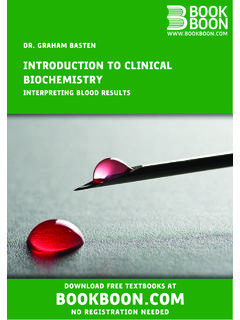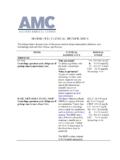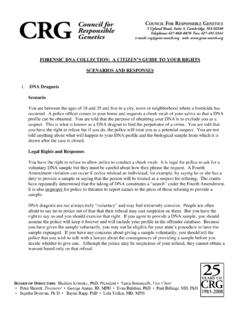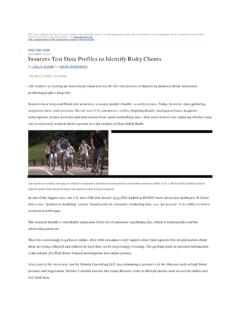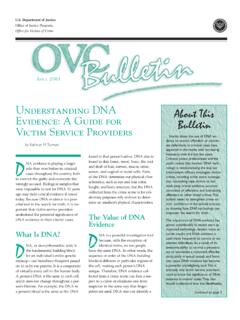Transcription of THE IMMUNE SYSTEM - Duquesne University
1 Grade Level 3-5. Sergeant Cell's IMMUNE SYSTEM Defense Team Webquest Activity Summary Comparing IMMUNE cells with a police team, the webquest activity guides students to research the IMMUNE SYSTEM online. At the end of their research, students will create Profiles for the molecule or cell of their choice. WEBQUEST. Y our students will learn: The 4 major types of cells of the IMMUNE SYSTEM and explain what their jobs are. How the IMMUNE SYSTEM remembers germs. How a vaccine works. Full educational standards available on- line at THE IMMUNE . SYSTEM . Teacher Pages Content Developers Gerra Bosco and Brianne Miller Grade Level Topic Description IMMUNE webquest- Teacher This Webquest is This Webquest was developed as part of the multimedia educational project designed for students Regenerative Medicine Partnership for Life. This project is funded by the National Institutes of Health and the National Center for Resource Research. in third to fifth grade.
2 Instructors at the The Webquest is designed to help students acquire new knowledge about the middle school level, IMMUNE SYSTEM : its function and benefits, its role in health defense, and the however, can adapt the different types of cells and tissues that work together to protect our body. Webquest for use in Standards their classrooms as well. 2. National Science Education Standards Science in Personal and Social Perspectives CONTENT STANDARD F (Grades K-4): Skills As a result of activities in grades K-4, all students should develop understanding of Associate o Personal health Create Describe Science in Personal and Social Perspectives CONTENT STANDARD F (Grades 5-8): Draw As a result of activities in grades 5-8, all students should develop understanding of Differentiate o Personal health explain o Risks and benefits Identify o Science and technology in society Illustrate Infer ISTE National Educational Technology Standards for Students (Grades 3-5).
3 Name Order Performance Indicators: All students should have opportunities to demonstrate the following performances. Prior to completion of Grade 5 students will: 1. Use keyboards and other common input and output devices (including adaptive devices when necessary) efficiently and effectively. (1). 3. Discuss basic issues related to responsible use of technology and information and describe personal consequences of inappropriate use. (2). 4. Use general purpose productivity tools and peripherals to support personal productivity, remediate skill deficits, and facilitate learning throughout the curriculum. (3). 5. Use technology tools for individual and collaborative writing, communication, and publishing activities to create knowledge products for audiences inside and outside the classroom. (3, 4). 8. Use technology resources for problem solving, self-directed learning, and extended learning activities. (5, 6). 9. Determine when technology is useful and select the appropriate tool(s) and technology resources to address a variety of tasks and problems.
4 (5, 6). Resources and Materials Process IMMUNE webquest- Teacher Your students will use the internet to explore the human IMMUNE SYSTEM . Students Computer lab/computer will work in pairs to complete the interdisciplinary Webquest activity during one area class period (30-45 minutes). Plan for more time if you feel your students need it. Computers (one for each Please advise your students to follow the directions in the Reading Guide, review pair of students) the rubric that will be used to evaluate their work, check off each box as a step is Photocopies of the completed, and use their Brainstorm Sheet (Applicant profile Worksheet) to record Capture, Identify, and ideas. Activate! Webquest (one copy for each student) After they all finish collecting information, they should begin filling out the Photocopies of Employment Profiles provided as a separate handout. It is best if the assignment 3. Employment Profiles is completed in class with their partner.
5 Decide how many days your students will (one copy for each pair of have to complete their assignment and set a due date. Pairs will then present their students). project in front of the class. Pencils Why Use This Webquest? We all get sick sometimes, but most of the time our bodies protect us from foreign Things to Consider invaders. This webquest introduces your students to the major players in the Before Implementing this IMMUNE SYSTEM and helps them to understand how our IMMUNE SYSTEM tries to Webquest in the Classroom: prevent us from getting sick and how it fights disease when germs get past our defenses. Pair students into effective cooperative partner groups (see By using this Webquest, in conjunction with Dr. Allevable's Laboratory Website below). and the Dr. Allevable and Regenerobot's Exploration Adventure workbook, the Reserve time/class period IMMUNE SYSTEM will come alive in your classroom! This Webquest, in particular, in the computer lab.
6 Helps integrate technology into your classroom and bring your students new Review proper computer knowledge in a fun, interactive, and engaging manner. lab etiquette. Copy Capture, Identify, Adaptations and Activate! Webquest Reading Guides for Students should work in pairs in the computer lab to create an evaluative students. product. The partners can be previously chosen by the teacher to ensure that all levels of learners are able to complete this task ( a lower-level learner Implement necessary may be paired with a higher-level learner). This pairing style helps students academic adaptations work collectively and practice cooperative skills and social skills. Additionally, (see below for students can practice delegation of roles and division of tasks to complete and suggestions). create the assignment. Review and revise the Students will present their finished evaluative products to the entire class with suggested rubric. a partner. As partners, students scaffold each other's learning and create more advanced products/ideas than if they worked on an individual basis.
7 If a student has a visual learning impairment, feel free to create learning guides using larger print or Braille. Additionally, consider using a mouse with a magnifying feature to aid them in reading smaller texts on a website. This activity should not create problems for students with auditory impairments as the RegMed IMMUNE SYSTEM Website does not contain sound effects that would impede comprehension. For this Webquest, your students will be using the following websites: IMMUNE webquest- Teacher Official RegMed IMMUNE SYSTEM Website Sponsored by the multimedia educational project Regenerative Medicine . Partnership for Life. Kid's Health Problems Find out more information about different kinds of health problems kids can have that affect their IMMUNE SYSTEM ! 4. Sergeant Cell's IMMUNE Webquest - Teacher IMMUNE SYSTEM Defense Team Webquest 5. The IMMUNE SYSTEM is a very important and integral part of the human body. The IMMUNE SYSTEM is not located in a specific organ; it is easiest to think of it as a complex constellation of different cells and tissues working together to protect nearly every area of our body.
8 The most important function of the IMMUNE SYSTEM is to distinguish what cells and substances are healthy and belong to your body and which aren't! The IMMUNE SYSTEM is able to do this by detecting and fighting infections caused by germs and other harmful things, like viruses, bacteria, fungal infections and parasites, in our bodies. The cells of the IMMUNE SYSTEM are known as white blood cells. Each type of cell performs certain functions, such as killing damaged or infected cells, carrying messages, making antibodies, or carrying away debris. There are four major types of white blood cells: T cells, B cells, Neutrophils and Macrophage. 1. T cells are the most important white blood cell; they coordinate the activities of the other white blood cells and are essential for fighting disease. 2. B cells also play an important role in protecting our bodies; they produce and release special proteins called antibodies. Antibodies stick to the surface of germs in our bodies, thus disabling them From top to bottom: and also making them a target for another type of cell called macrophage macrophage, T cell and (mack'-row-fage).
9 3. Macrophage (from the Latin macro = big, phage = eat) are white blood cells B cell. that literally eat germs covered by antibodies. 4. Neutrophils (new'-tro-fills) are the white blood cells that are the first responders to infections. We have more neutrophils than any other type of white blood cell. Their job is to patrol the body looking for germs. When they find an infection, they send a signal to our T cells, and our T cells send the other white blood cells to the infection. Each B cell only makes one type of antibody, but Memory B cells can remember all the germs they've found for your whole life! Because your body remembers what germs look like, any time that germ comes back your body can get rid of it very quickly before you even know you're infected! This is why you can only get sick from a disease one time (like Chicken Pox). You might be thinking, But I've had a lot of colds! The common cold is actually caused by many different types of viruses that all cause the same symptoms.
10 IMMUNE Webquest - Teacher This is why you can catch a cold more than once. Because there are so many types of viruses that cause the common cold, there is no vaccine for the common cold. Vaccines work by showing your body what a single germ looks like, just like a Most Wanted sign. After you get a vaccine shot, your B cells will produce antibodies against that germ and become Memory B cells that will remember that germ. Antibodies will only stick to germs, except in rare cases of autoimmune diseases where the antibodies mistake our own healthy cells for invaders. 6. Applicant #1- The Skin Students Should: Go to the following website: Click the General Mechanisms link at the top of the webpage. Read the text on the webpage that appears. Answer the following questions: 1. Lots of weird things like hairs and mucous really help defend your body. In particular the skin! Why is the skin a major defense mechanism for the IMMUNE SYSTEM ? The skin poses a physical barrier.


